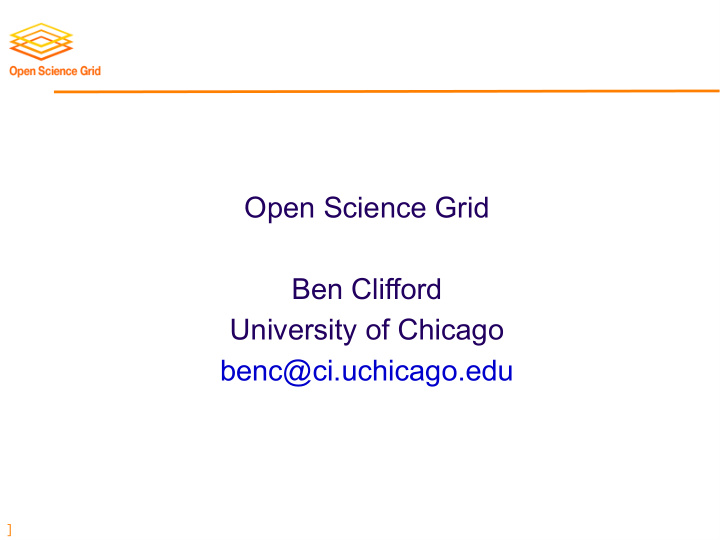



Open Science Grid Ben Clifford University of Chicago benc@ci.uchicago.edu ]
T he Open S c ienc e Grid vision Transform processing and data intensive science through a cross- domain self-managed distributed cyber- infrastructure that brings together campus and community infrastructure and facilitating the needs of Virtual Organizations (VO) at all scales ] 2
T he E volution of the OS G LIGO operation LIGO preparation LHC construction, preparation LHC Ops iVDGL (NSF) OSG GriPhyN (NSF) Trillium Grid3 (DOE+NSF) PPDG (DOE) DOE Science Grid (DOE) 1999 2000 2001 2002 2003 2004 2005 2006 2007 2008 2009 European Grid + Worldwide LHC Computing Grid Campus, regional grids ] 3
Initial Grid driver: High Energy Physics ~PBytes/sec 1 TIPS is approximately 25,000 Online System ~100 MBytes/sec SpecInt95 equivalents Offline Processor Farm There is a “bunch crossing” every 25 nsecs. ~20 TIPS There are 100 “triggers” per second ~100 MBytes/sec Each triggered event is ~1 MByte in size Tier 0 Tier 0 CERN Computer Centre ~622 Mbits/sec or Air Freight (deprecated) Tier 1 Tier 1 France Regional Germany Regional Italy Regional FermiLab ~4 TIPS Centre Centre Centre ~622 Mbits/sec Tier 2 Tier 2 Caltech Tier2 Centre ~1 Tier2 Centre ~1 Tier2 Centre ~1 Tier2 Centre ~1 ~1 TIPS TIPS TIPS TIPS TIPS ~622 Mbits/sec Institute Institute Institute Institute ~0.25TIPS Physicists work on analysis “channels”. Each institute will have ~10 physicists working on one or more Physics data cache ~1 MBytes/sec channels; data for these channels should be cached by the institute server Tier 4 Tier 4 Physicist workstations Image courtesy Harvey Newman, Caltech 4
Kuhlman Biology : • Designing proteins that fold into specific structures and bind target molecules • Millions of simulations lead to the creation of a few proteins in the wet-lab • Brought to OSG’s attention by local One protein can fold in many campus research computing group that ways. This computationally was being overwhelmed designed protein switches between a zinc finger • Assistant Professor and a lab of 5 structure and a coiled-coil structure, depending on its graduate students environment. • http://www.isgtw.org/?pid=1000507 ]
Designing proteins in the Kuhlman Lab Designing proteins in the Kuhlman Lab For each protein we design, we consume about 5,000 CPU hours across 10,000 jobs,” says Kuhlman. “Adding in the structure and atom design process, we’ve consumed about 250,000 CPU hours in total so far.” ]
● 1.6 * 10^8 CPU-hours/year, 5 CPU-hours/sec ● http://www.opensciencegrid.org/Usage_Stats
Example: UJ cluster can provide ~10k CPU-hours per week right now, planned 32k
What OS G would like ... • Involvement as users: application users at UJ making use of other OSG resources – use UJ cluster and through that develop grid-scale applications resource provision – other OSG users use space compute capacity here ]
Recommend
More recommend